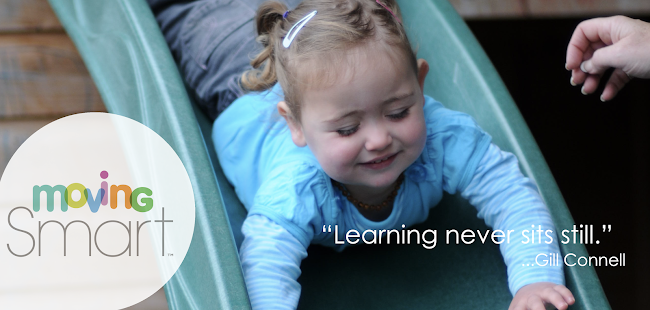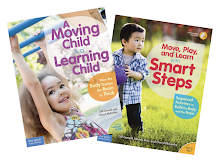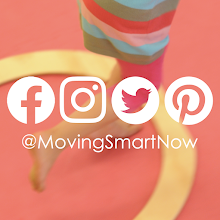Lucky me! The
other day I had a "Charlie Day" with my grandson (whose name is Jakie
not Charlie, but that’s a story for another day). Charlie Days consist of a
sleepover followed by a full day of fun for just the two of us. No mommies, daddies,
or big sisters allowed!
Jakie is a
loving, gentle child with the typical tornadic energy you would expect from a
three-going-on-four year old boy. That means Charlie Days are why-walk-when-we-can-run
days!
Fun, but phew!
Why
Kids Love Fast!
It seems that just
minutes after their first steps, little ones are off and running. Not walking. Running! I love that stage, watching
them relish the freedom of their own two feet.
And certainly,
going fast feels good and is a large
part of why “fast” is a young child’s default speed. But it’s not the only
reason.
You see “fast” is actually easier than “slow”
for young children. That’s
because when the human body moves fast, the physics of forward momentum take
over part of the job our sense of balance normally does for us. When we move
slow, we rely more on our balance to keep us steady, stable, and upright. And
that’s where the challenge comes in for little ones.
As we’ve written
about before, children aren’t born with
a sense of balance. Balance is developed in the early years through the natural
process of movement. As such, when children do get to their feet, the brain
and body are working double-time, managing balance and complex movements simultaneously. And of course, that takes some getting used to… actually
years of getting used to in order to perfect the highly sophisticated act of
moving at a slow, controlled pace!
Why
Slow Matters
Now, going fast is perfectly natural and great for kids. But it’s important to try to slow them down too... at least
sometimes. You see, going fast doesn’t
give the brain time to think. Going slow engages the brain, giving it the time
it needs to receive, analyze, and store all that sensory information. This
helps build the brain’s sense of balance while refining movement. And when that
happens, children are on the road to more deliberate control of their bodies…
and yes, they might even slow down a bit!
So, how slow can you go? Here are 10 fun ideas I’ve used
at home and in my classroom that kids might just slow down for...
Ready?
Set. Slow!
1. THE GO-SLOW
CHALLENGE! Little ones naturally want to please us and naturally want to show
off what they can do, so when they’re dashing about at top speed, say to them,
“Oh my goodness, you really can go fast! I bet you can’t go slow!”
3. TURTLE! TIGER! TREE! To give little ones a full sense of their own self-control, give them practice changing speed. For instance, when you call out “turtle” they need to walk very, very slow. When you call out “tiger” they need to speed up and move very, very fast. When you call out “tree” they need to stretch their “limbs” like a tree and freeze in place! At first, do this with a predictable rhythm. Once they’ve got the hang of it, change to a more random/unpredictable rhythm. And be sure to change the sequence so they have to listen carefully.
4. CAREFUL! CAREFUL!
Set up activities that require them to be careful and precise in their
movements. For instance, crawl through the tunnel without touching the sides or
carry a ping pong ball on a spoon from one end of the yard to the other.
5. GIANT STEPS. The
bigger the gait the slower the movement, so have the children walk across the
room or play yard using giant steps. Once they have a feel for it, have them
count how many steps it takes to get from start to finish. Now have them come
back the other way and see if they can do it in even fewer steps!
6. TWO BY TWO. Pair
up the children standing back to back, linking arms. Now challenge them to
cross the room or play yard. Without even asking, they’ll automatically move
more slowly as they negotiate their movements with each other.
8. SLOW TALK. Doing anything slowly will help children understand how to pace themselves. Talking slow is a really fun way to develop auditory discrimination while sounding out words and at the same time giving them “slow” practice. Model slow talking for them and encourage them to repeat words or phrases you say. Then let them loose to slow chat with each other. It’s hilarious!
9. SLOW TALK &
WALK. Once they’ve practiced Slow Talk, add a movement challenge for even more
fun. For instance, take a trip back to the Slow Zoo. Have the children move
like their favorite slow animal while describing their movements in Slow Talk.
“I ammmm walllkkking lllikkke aaaaa turrrrrtlllle.”
10. IT’S SLOW TIME!
Indoors or out, play any favorite game but take it slow. Great games for this
are Follow the Leader or Simon Says, but try this idea with any game the children
already know. Taking it slow will make the game different, challenging,
(and often silly) for them!
WANT TO KNOW MORE?
If you're interested in learning more ways to help children develop balance and control, you might enjoy these posts...
DEVELOPING BALANCE: THE SPIN CYCLE
SMART STEPS: LET 'EM ROLL
WANT TO KNOW MORE?
If you're interested in learning more ways to help children develop balance and control, you might enjoy these posts...
DEVELOPING BALANCE: THE SPIN CYCLE
SMART STEPS: LET 'EM ROLL


















No comments:
Post a Comment